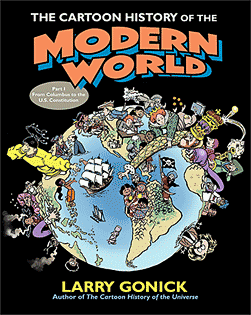
When I was about twelve, I picked up The Cartoon History of the Universe: From the Big Bang to Alexander the Great while on holiday in the states. I read it, loved it and reread it until about three years later, when on another stateside trip I stumbled across The Cartoon History of the Universe II: From the Springtime of China to the Fall of Rome. I was equally enamoured, and painstakingly painted copies of the panels detailing Jesus' teachings onto my schoolbag. After a painfully long wait, in 2003 I found The Cartoon History of the Universe III: From the Rise of Arabia to the Renaissance in a St. Louis bookstore (possibly the same in which I had found Vol. 1? I'm not sure) and happily devoured its depictions of Islam's ascendancy and the Crusades while the allies settled in in Iraq. Since then I have mastered internet shopping, and have been twitching with excitement since last week when I realised that Larry Gonick had published the fourth collection earlier this year: The Cartoon History of the Modern World, Part I: From Columbus to the U.S. Constitution. It arrived this morning, and I have been reading it with a strange sadness of understanding that in a few years I will happen upon Part II, and the history of the universe will be over.
They are a truly marvellous series of books, written and drawn with flair, insight and wit by Larry Gonick, interviewed here. He has a great feel for the interconnectedness of history, drawing links between geographically and chronologically disparate events. It's an angle which suits the form. A fifty page comic (one chapter) is necessarily selective and fast paced, and Gonick manages to use the structure to create a broad continuity, while also cramming in as much curious and hilarious detail as he can. As a result, Cortez does not seem that far from Caesar, whether in action or in caricature. Amusing despots rise and fall; ideas and diseases race each other across the world; and the narrator despairs at having to draw massacre after massacre (I can't think of a comic which contains more corpses), while exclaiming with glee whenever an elephant pops up in the story. The narration is knowing, always on the lookout for irony, and aware of the medium's deficiencies: Gonick's wild-haired alter ego lets us know early on that Herodotus is his favourite historian, because he makes up all the dialogue. I really can't think of a better thing to do with one's life.
Tuesday, July 31, 2007
The History of the Universe goes on.
Posted by
Roger
at
1:13 PM
![]()
Labels: Comics, History, Larry Gonick
Subscribe to:
Post Comments (Atom)


No comments:
Post a Comment